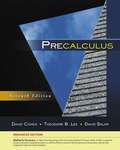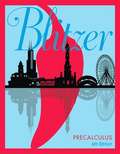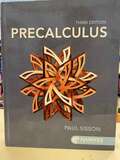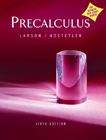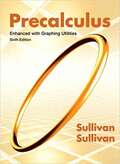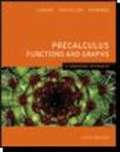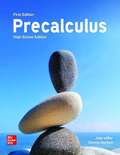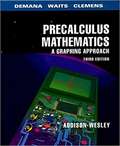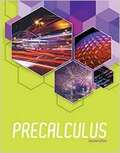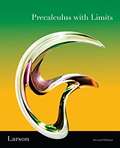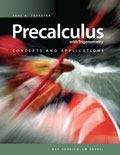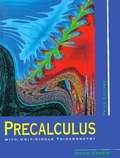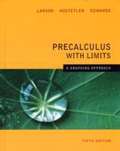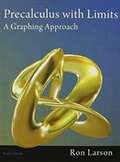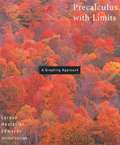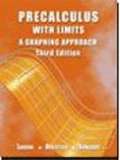- Table View
- List View
Precalculus (Mindtap Course List Ser.)
by David Sklar David Cohen Theodore LeeNever HIGHLIGHT a Book Again! Includes all testable terms, concepts, persons, places, and events. Cram101 Just the FACTS101 studyguides gives all of the outlines, highlights, and quizzes for your textbook with optional online comprehensive practice tests. Only Cram101 is Textbook Specific. Accompanies: 9781305663107. This item is printed on demand.
Precalculus (Second Edition)
by Robert BlitzerDesigned to help students transition from intermediate algebra to calculus in the process helping students enhance their problem solving skills and become critical thinkers as they tackle real world problems
Precalculus (Sixth Edition)
by Robert BlitzerWith the new edition, Blitzer takes student engagement with the mathematical world to a whole new level drawing from applications across all fields as well as topics that are of interest to any college student (e.g., student loan debt, grade inflation, sleep hours of college students). Applications are also brought to life online in a new, assignable video series that explore the entertaining and mathematical Blitzer Bonus boxes. The new edition also aims to help more students to succeed in the course with just-in-time support in the text--such as Brief Review of prerequisite topics, Achieving Success boxes, and Retain the Concepts exercises--as well as support within MyLab™ Math such as new concept-level videos, assignable tools to enhance visualization, and more.
Precalculus Advanced Placement
by Ron LarsonWelcome to Pre calculus, Sixth Edition. In this revision we continue to focus on promoting student success, while providing an accessible text that offers flexible teaching and learning options. In keeping with our philosophy that students learn best when they know what they are expected to learn, we have retained the thematic study thread from the Fifth Edition.
Precalculus Concepts through Functions Fourth Custom Edition for Jamestown Community College
by Michael SullivanPrecalculus Concepts through Functions Fourth Custom Edition for Jamestown Community College
Precalculus Enhanced With Graphing Utilities
by Michael SullivanPrepare, Practice, Review <P><P>The Sullivan’s time-tested approach focuses students on the fundamental skills they need for the course: preparing for class, practicing with homework, and reviewing the concepts. The Enhanced with Graphing Utilities Series has evolved to meet today’s course needs by integrating the usage of graphing calculators, active-learning, and technology in new ways to help students be successful in their course, as well as in their future endeavors. <P><P>In the Seventh Edition, there are several new features that appear in both the text and MyMathLab. Retain Your Knowledge problems offer the type of “final exam material” that students can use to maintain their skills throughout each chapter.
Precalculus Functions And Graphs: A Graphing Approach
by Ron Larson Robert Hostetler Bruce Edwards David FalvoPart of the market-leading Graphing Approach Series by Larson, Hostetler, and Edwards, Precalculus Functions and Graphs: A Graphing Approach, 5/e, is an ideal student and instructor resource for courses that require the use of a graphing calculator. The quality and quantity of the exercises, combined with interesting applications and innovative resources, make teaching easier and help students succeed. Continuing the series' emphasis on student support, the Fifth Edition introduces Prerequisite Skills Review. For selected examples throughout the text, the Prerequisite Skills Review directs students to previous sections in the text to review concepts and skills needed to master the material at hand. In addition, prerequisite skills review exercises in Eduspace are referenced in every exercise set. The Larson team achieves accessibility through careful writing and design, including examples with detailed solutions that begin and end on the same page, which maximizes the readability of the text. Similarly, side-by-side solutions show algebraic, graphical, and numerical representations of the mathematics and support a variety of learning styles.
Precalculus High School
by Julie Miller Donna GerkenJulie Miller wrote her developmental math series because students were coming into her Precalculus course underprepared. They weren t mathematically mature enough to understand the concepts of math nor were they fully engaged with the material. She began her developmental mathematics offerings with intermediate algebra to help bridge that gap. The Precalculus series is a carefully constructed end to that bridge that uses the highly effective pedagogical features from her fastest growing developmental math series. What sets Julie Miller s series apart is that it addresses course issues through an author-created digital package that maintains a consistent voice and notation throughout the program. This consistency--in videos, PowerPoints, Lecture Notes, and Group Activities--coupled with the power of ALEKS and Connect Hosted by ALEKS, ensures that students master the skills necessary to be successful in Precalculus and can carry them through to the calculus sequence."
Precalculus Student Edition
by Bju PressLessons in the student text thoroughly develop key concepts, provide detailed examples to promote student comprehension, and integrate practical applications. Exercise sets include three levels of difficulty to allow differentiated assignments. Each section includes cumulative review to help with long-term mastery and to prepare students for standardized tests. Students will have the opportunity to use technology to explore mathematical concepts.
Precalculus With Limits
by Ron LarsonWith the same design and feature sets as the market leading Precalculus, 8/e, this addition to the Larson Precalculus series provides both students and instructors with sound, consistently structured explanations of the mathematical concepts. Designed for a two-term course, this text contains the features that have made Precalculus a complete solution for both students and instructors: interesting applications, cutting-edge design, and innovative technology combined with an abundance of carefully written exercises. In addition to a brief algebra review and the core precalculus topics, PRECALCULUS WITH LIMITS, International Edition, covers analytic geometry in three dimensions and introduces concepts covered in calculus.
Precalculus With Trigonometry: Concepts and Applications
by Paul A. FoersterIf you shoot an arrow into the air, its height above the ground depends on the number of seconds since you released it. In this chapter you will learn ways to express quantitatively the relationship between to variables such as height and time. You will deepen what you have learned in previous courses about functions and the particular relationships that they describe for example, how height depends on time.
Precalculus With Unit-circle Trigonometry
by David CohenIn this new ADVANTAGE SERIES version of David Cohen's PRECALCULUS: WITH UNIT CIRCLE TRIGONOMETRY, THIRD EDITION, Cohen continues to offer a book that is accessible to the student through a careful progression and presentation of concepts, rich problem sets and examples to help explain and motivate concepts, and continual guidance through the challenging work needed to master concepts and skills. This book is identical to PRECALCULUS: A PROBLEMS-ORIENTED APPROACH, Fifth Edition with the exception of the first four chapters on trigonometry. As part of the ADVANTAGE SERIES, this new version will offer all the quality content you've come to expect from Cohen sold to your students at a significantly lower price.
Precalculus with Limits
by Ron Larson Robert Hostetler David C. FalvoWith the same design and feature sets as the market leading Precalculus, 7/e, this new addition to the Larson/Hostetler Precalculus series provides users with sound, consistently structured explanations of the mathematical concepts. This book contains the features that have made Precalculus a complete solution for users: interesting applications, cutting-edge design, and innovative technology combined with an abundance of carefully written exercises. In addition to a brief algebra review and the core precalculus topics, PRECALCULUS WITH LIMITS covers analytic geometry in three dimensions and introduces concepts covered in calculus.
Precalculus with Limits
by Ron Larson David C. FalvoWith the same design and feature sets as the market leadingPrecalculus,7/e, this new addition to the Larson/Hostetler Precalculus series provides both students and instructors with sound, consistently structured explanations of the mathematical concepts. Designed for a two-term course, this text contains the features that have madePrecalculusa complete solution for both students and instructors: interesting applications, cutting-edge design, and innovative technology combined with an abundance of carefully written exercises. In addition to a brief algebra review and the core precalculus topics,Precalculus with Limitscovers analytic geometry in three dimensions and introduces concepts covered in calculus. Side-by-side Example Solutionsfor select examples include multiple problem solving approaches-such as algebraic, graphical, and numerical-to appeal to a variety of teaching and learning styles. Checkpointsafter each Example/Solution refer students to similar drills in the Section Exercises, allowing students to practice and reinforce the concepts they just learned. Answers to Checkpoints are included at the back of the book. New!Vocabulary Checksopen every set of Section Exercises. This review of mathematical terms, formulas, and theorems provides regular assessment and reinforcement of students' understanding of algebraic language and concepts. Exercise Setshave been carefully analyzed and revised to improve the categorization of problems frombasic skill-buildingtochallenging;improve the pairing of similar odd- and even-numbered exercises; update all real data; and add real-life and real-data applications. New!Make a Decisionapplications-presented throughout the text at the end of selected exercise sets-are based on large sets of real data. These extended modeling applications give students the opportunity to use all the mathematical concepts and techniques they've learned and apply them to large sets of real date-analyzing it, graphing it, and making conjectures about its behavior. These applications are featured in Eduspace and the Online Learning Center in an interactive format. Eduspace, powered by Blackboard,Houghton Mifflin's online learning environment, brings your students quality online homework, tutorials, multimedia, and testing that correspond to thePrecalculus with Limitstext. This content is paired with the recognized course management tools of Blackboard.
Precalculus with Limits
by Ron Larson David C. FalvoWith the same design and feature sets as the market leading Precalculus, 7/e, this new addition to the Larson/Hostetler Precalculus series provides both students and instructors with sound, consistently structured explanations of the mathematical concepts. Designed for a two-term course, this text contains the features that have made Precalculus a complete solution for both students and instructors: interesting applications, cutting-edge design, and innovative technology combined with an abundance of carefully written exercises. In addition to a brief algebra review and the core precalculus topics, Precalculus with Limits covers analytic geometry in three dimensions and introduces concepts covered in calculus.
Precalculus with Limits (Texas Edition)
by Ron Larson Robert HostetlerThis new precalculus textbook focuses on making the mathematics accessible, supporting student success, and offering teachers flexible teaching options. It thoroughly covers the topics of a traditional precalculus text with the addition of two new chapters. Chapter 11 encompasses analytic geometry in three dimensions and Chapter 12 introduces students to the key calculus topics, including limits, the tangent line problem, and the area problem.
Precalculus with Limits with CalcChat® and CalcView®
by Ron Larson Paul BattagliaNIMAC-sourced textbook
Precalculus with Limits: A Graphing Approach
by Ron Larson Robert Hostetler Bruce H. Edwards David C. FalvoAs part of the market-leadingGraphing ApproachSeries by Larson, Hostetler, and Edwards,Precalculus with Limits: A Graphing Approach,4/e, provides both students and instructors with a sound mathematics course in an approachable, understandable format. The quality and quantity of the exercises, combined with interesting applications, cutting-edge design, and innovative resources, make teaching easier and help students succeed in mathematics. This edition, intended for precalculus courses that require the use of a graphing calculator, includes a moderate review of algebra to help students entering the course with weak algebra skills. Accessibility to students is achieved through careful writing and design, including same-page examples and solutions, which maximize the readability of the text. Similarly, side-by-side solutions show algebraic, visual, and numeric representations of the mathematics to support students' various learning styles. TheLibrary of Functionsthread throughout the text provides a definition and list of characteristics for each elementary function and compares newly introduced functions to those already presented to increase students' understanding of these important concepts. Technology Supportnotes provided at point-of-use throughout the text guide students to theTechnology Support Appendix,where they can learn how to use specific graphing calculator features to enhance their understanding of the concepts presented. Houghton Mifflin'sEduspaceonline classroom management tool offers instructors the option to assign homework and tests online, provides tutorial support for students needing additional help, and includes the ability to grade any of these assignments automatically.
Precalculus with Limits: A Graphing Approach
by Ron Larson Robert Hostetler Bruce H. Edwards David C. FalvoWritten by the author, this manual offers step-by-step solutions for all odd-numbered text exercises as well as Chapter and Cumulative tests. In addition to Chapter and Cumulative tests, the manual also provides practice tests and practice test answers.
Precalculus with Limits: A Graphing Approach
by Bruce H. Edwards Robert P. Hostetler Roland E. LarsonCollated with the main goal of helping students develop an understanding of algebra and trigonometry and how they are related to real life problems.
Precalculus with Limits: A Graphing Approach
by Ron Larson David C. FalvoAs part of the market-leadingGraphing ApproachSeries by Larson, Hostetler, and Edwards,Precalculus with Limits: A Graphing Approach,4/e, provides both students and instructors with a sound mathematics course in an approachable, understandable format. The quality and quantity of the exercises, combined with interesting applications, cutting-edge design, and innovative resources, make teaching easier and help students succeed in mathematics. This edition, intended for precalculus courses that require the use of a graphing calculator, includes a moderate review of algebra to help students entering the course with weak algebra skills. Accessibility to students is achieved through careful writing and design, including same-page examples and solutions, which maximize the readability of the text. Similarly, side-by-side solutions show algebraic, visual, and numeric representations of the mathematics to support students' various learning styles. TheLibrary of Functionsthread throughout the text provides a definition and list of characteristics for each elementary function and compares newly introduced functions to those already presented to increase students' understanding of these important concepts. Technology Supportnotes provided at point-of-use throughout the text guide students to theTechnology Support Appendix,where they can learn how to use specific graphing calculator features to enhance their understanding of the concepts presented. Houghton Mifflin'sEduspaceonline classroom management tool offers instructors the option to assign homework and tests online, provides tutorial support for students needing additional help, and includes the ability to grade any of these assignments automatically.
Precalculus with Limits: A Graphing Approach (2nd Edition)
by Ron Larson Bruce H. Edwards Robert R HostetlerDesigned to build a strong foundation in precalculus, this premier text for a reform-oriented course encourages students to develop a firm grasp of the underlying mathematical concepts while using algebra as a tool for solving real-life problems. The comprehensive text presentation invites discovery and exploration, while the integrated technology and consistent problem-solving strategies help the student develop strong precalculus skills.
Precalculus with Limits: A Graphing Approach (3rd Edition)
by Ron Larson Bruce H. Edwards Robert P. HostetlerIn the Third Edition, we have revised and improved upon many text features designed for this purpose. Our pedagogical approach includes presenting solutions to examples from multiple perspectives-algebraic, graphic, and numeric. The side-by-side format allows students to see that a problem can be solved in more than one way, and to compare the accuracy of the solution methods.
